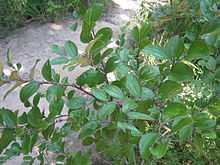Ziziphus nummularia
| Ziziphus nummularia | |
|---|---|
 | |
| Z.nummularia in Panchkhal valley, Nepal | |
| Scientific classification | |
| Kingdom: | Plantae |
| (unranked): | Angiosperms |
| (unranked): | Eudicots |
| (unranked): | Rosids |
| Order: | Rosales |
| Family: | Rhamnaceae |
| Genus: | Ziziphus |
| Species: | Z. nummularia |
| Binomial name | |
| Ziziphus nummularia (Burm.f.) Wight & Arn. | |
| Synonyms[1] | |
|
Ziziphus rotundifolia | |
Ziziphus nummularia, also called Jharber (Hindi: झड बेर), is a species of Ziziphus native to the Thar Desert of western India and southeastern Pakistan and south Iran (where it is called رمیلک ramilak in Persian).
Ziziphus nummularia is a shrub up to 2 metres (6.6 ft) high, branching to form a thicket. The leaves are rounded like those of Ziziphus zizyphus but differ from these in having a pubescence on the adaxial surface. The plant is commonly found in agricultural fields.
Uses
Food
The fruit is either eaten fresh, pickled, dried or made into confectionery. The juice can bemade into a refreshing drink. In India, the fruit, when fully ripe and less than one centimeter in diameter, are gathered in the beginning of the winter months, dried, ground, and sieved. The powder formed is eaten either alone, mixed with Gur (a sugar condiment) or Bajra (millet) flour.
Fodder
The leaves of Z. nummularia provide excellent fodder for livestock. In India, the average total yield of forage was about 1000 kg ha-1. The leaves are collected dried and stored.
Fuel
It is a source of high calorific value (4400 kcal/kg) fuel and charcoal Timber: The heartwood is yellow to dark brown, hard, 738 kg/m3 and it is used in farm implements and for house construction.
Medicine
Dried fruit used medicinally as astringent in bilious affliction in India. The leaves are used to treat scabies and other skin diseases. Poison: The fruits are greedily eaten by gerbils and rats and are used as baits for poisoning these rodents.
Intercropping
Z. nummularia shrubs are often intercropped with millet, legumes and oil seeds
Erosion control
The shrubs have been shown to effectively check wind erosion, help in deposition of soil, and bring about a change in the microhabitat, causing favourable conditions for the appearance of successional species such asperennial grasses
Boundary or barrier or support
In India, it is commonly erected as ‘brush-wood barriers’ (micro-windbreaks) together with Crotalaria burhia.
Reclamation
It has proved successful in sand dune stabilization in India.
Tree management
It produces copious coppice shoots and roots suckers forming dense thorny thickets often collecting moulds of leaves and dust.
Germplasm management
Seed storage behaviour is orthodox. There are 1800-2000 seeds/Kg
Pests and diseases
This species is a host of larvae of butterfly Tarucus balkanica Freyer in Africa, Balkans, Iran, Asia Minor, Lebanon and Mauritania.[2]
See also
References
- ↑ United States Department of Agriculture: "Germplasm Resources Information Network"
- ↑ avasthi, kapil; kuldeep (2013-05-13). "synthesis of nanoparticle from zazipus nummularia". synthesis of nanoparticles from ziziphus nummularia. 2010-2012 (jib): 50. Check date values in:
|accessdate=(help);
- RN Kaul (1963): Need for afforestation in the arid zones of India, LA-YAARAN, Vol 13
- RC Ghosh (1977): Hand book on afforestation techniques, Dehradun.
- RK Gupta & Ishwar Prakasah (1975): Environmental analysis of the Thar Desert, Dehradun.